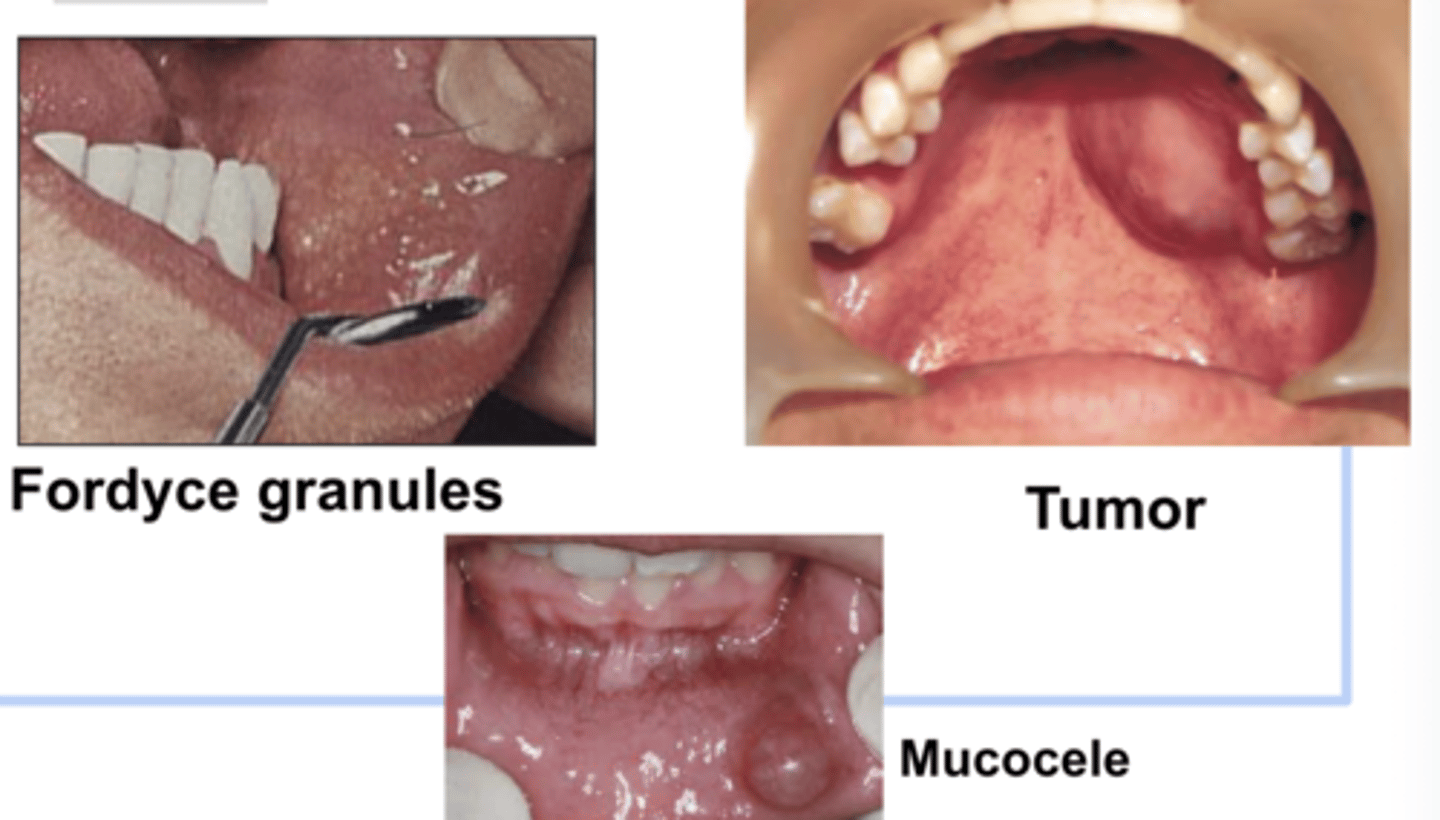Saliva and Salivary Glands
1/34
There's no tags or description
Looks like no tags are added yet.
Name | Mastery | Learn | Test | Matching | Spaced |
|---|
No study sessions yet.
35 Terms
How do we classify salivary glands
location, size, and nature of secretion
What are the major salivary glands?
parotid, submandibular, sublingual
Describe the Parotid Gland (location, duct, secretions)
location: beneath and under each ear
duct: stenson's duct (looks like a flap of tissue by maxillary second molar)
secretion: serous, 25% of all saliva
Describe the Submandibular Gland (location, duct, secretions)
location: submandibular triangle below the jaw
duct: wharton's (drains from here, comes out of sublingual cruncle)
secretion: mixed, mostly serous, 60-65% of all saliva, produces most saliva
Describe the Sublingual Gland
location: floor of oral cavity
duct: bartholin's
secretion: mixed, mostly mucous, 10% of all saliva
Describe the lingual minor salivary gland (location, secretion)
located on the tip and psoterior aspect of the tongue
mucous and serous secretion
Describe the labial minor salivary gland (location, secretion)
located on labial mucosa
mucosa and serous secretion
Describe the buccal minor salivary gland (location, secretion)
located on buccal mucosa
mucosa and serous secretion
Describe the palate minor salivary gland (location, secretion)
located on soft palate and lateral aspects of hard palate
mucous secretion
Describe the traits of saliva
(smell, color, consistency, role, what is it like at resting and active states)
Odorless
Colorless or cloudy
Ropy (thick) or watery (thin)
Bathes teeth and tissues
Resting: unstimulated
Active: stimulated (10 x resting rate)
How does saliva flow?
flows day and night
produce 3 pints of saliva a day
Where does saliva come from in the resting sate?
major glands
How do we describe the amount of flow of saliva we have?
copious (heavy flow)
scanty (minimal flow)
How do we describe the viscosity of flow of saliva we have?
ropy (more mucous, thicker)
watery (more serous, runny)
What is the composition of saliva?
99% water, 1% solids
Describe the organic solids of saliva
Mucin (proteins)
Enzymes (amylase)
Antibodies
Blood clotting factors
Lipids
Describe the inorganic solids of saliva
Salts: bicarbonates, chlorides,
phosphates: (calcium, sodium, potassium)
Phosphates are called buffers
Describe Mucin (organic solid in saliva)
proteins in saliva
gives "sliminess" quality
Describe Enzymes (organic solid in saliva)
Begin digestive process
Ex: amylase
What is the normal pH level of saliva?
6.0 - 7.9 (generally around neutral)
How does saliva's pH fluctuate?
falls during sleep (acidic)
rises during eating (increase in salivary flow, basic)
falls after eating (acidic, signifiant in caries)
What does an increase in salivary flow cause?
increase in buffers available = increase in pH
Describe the concept of salivary flow increasing while we eat
calcium and phosphate (buffers) become more available in saliva
this then increases salivary pH (moves back to neutral/ normal for individual)
What increases salivary flow?
Sight/smell food
Mastication
Dental work
Pain
What decreases salivary flow?
Fear/anxiety
Sleep
Fever
Medications
After eating
Systemic conditions
(ex. Sjogren's)
What is xerostomia?
dry mouth
decrease of salivary production and ongoing dry mouth
What are the causes of xerostomia?
drug-induced/medication
radiation from cancer treatment that destroys salivary glands or salivary gland dysfunction
systemic problem like Sjogren's
What are the side effects of xerostomia?
mouth becomes more acidic because of lack of available buffers
residual saliva is more mucous- and viscous-like
What are the problems in the mouth of xerostomia?
mucositis, mouth infections, increase in caries and tissue inflammation
What are the treatments for xerostomia?
Biotene products
Daily fluoride products
Xylitol-containing gum to reduce strep mutans and increase salivary flow
Amorphous calcium phosphate (ACP): contains ca and phosph to help replenish those ions in tooth structure
practice good self care for plaque removal
What are the physical functions of saliva?
Lubricates oral cavity
Aids in the digestive process (enzymes)
Carrier
What are the chemical functions of saliva?
Neutralizing agent (buffers)
Aids in healing
Anti-bacterial
Excretory functions (ex. ANUG odor)
What are the clinical considerations for glands?
possible site of pathology; variations of normal
fordyce granules, tumor, mucocele

What are the clinical considerations for saliva?
Lubricant for speech and mastication
Role in plaque and calculus formation
Cleansing vs. retention of food
Absence: caries, tissue inflammation
Influence on health and disease
How do we test saliva?
Volume
Flow rates
Type (serous vs. mucous)
pH
Buffering ability